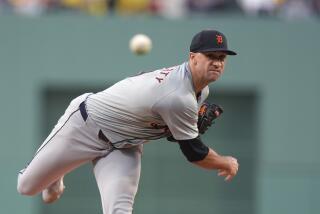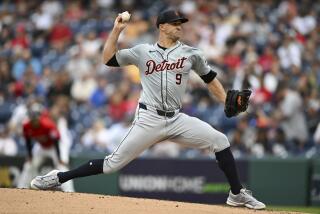Hampton Deal Is Complex for Quite a Few Reasons
- Share via
Let’s see if I have this right: the Florida Marlins will basically subsidize Mike Hampton’s attempt to regain his pre-Coors Field form with their division rival Atlanta Braves.
Whether Hampton, a $121-million bust in two years with the Colorado Rockies, can do it is uncertain, but it will cost the Braves comparatively little to find out.
In agreeing to pay the bulk of Hampton’s salary over the next three years to facilitate a complex trade involving eight players, three teams and the approval of Commissioner Bud Selig, the Marlins may have also provided the Braves with enough financial flexibility to retain free agents Tom Glavine or Greg Maddux, maybe both.
“We could not and would not have made this trade without substantial financial help from another club,” Atlanta General Manager John Schuerholz said by phone. “It was too rich in its original form. Our 2003 budget could not have handled it.”
The Braves are obligated to pay Hampton $48.5 million over the remaining six years of his contract, but only $5.5 million in the first three years.
The Marlins, who would have preferred to backload their financial responsibility to free payroll for seven key players eligible for arbitration, were so desperate to dump the $54.3 million remaining on the contracts of Preston Wilson and Charles Johnson without taking on equivalent salary in return that they agreed to pay Atlanta $30 million over the next three years. Of that $30 million, $6.5 million is coming from the Rockies, who in turn will have paid $49 million of Hampton’s $121-million contract but will now save about $22.3 million over the remaining six years of the contract.
This is the way the deal came down:
* The Rockies, who only two years ago invested almost $200 million in Hampton and Denny Neagle and have changed philosophy and direction each of their three years under General Manager Dan O’Dowd, traded Hampton and center fielder Juan Pierre to Florida for Wilson, Johnson, left-handed reliever Vic Darensbourg and second base prospect Pedro Ozuna.
* The Marlins then traded Hampton to the Braves for relief pitcher Tim Spooneybarger and minor league reliever Ryan Baker.
Hampton might not have waived his no-trade clause if Miami had been his final destination. He wanted to pitch for a contender, a case of unmitigated gall in the sense that Colorado had obligated to pay him millions of dollars to help them become a contender.
Instead, he was 21-38 in two years, and now the Braves hope he can emulate Darryl Kile’s 20-win success in the season after he left Coors.
“We’ve all seen the data on pitchers before Coors, during Coors and after Coors,” Schuerholz said. “Our reports indicate Hampton’s athleticism and arm action are as good as they were when he was winning regularly. He’s only 30. We think he can be the same pitcher” who went 22-4 with Houston in 1999 and 15-10 with the New York Mets in 2000.
With Atlanta obligated to pay only $2 million of his salary in 2003 (and with the possibility that the Braves could trade him after a three-year outlay of only $5 million if he doesn’t regain his form), Schuerholz acknowledged that the potential re-signing of Glavine and Maddux is more feasible.
“We’ll keep the dialogue going and see what happens,” he said. “There are so many uncertainties in this free-agent market that you never know what’s around the next corner.”
With agent Scott Boras doing the driving, the next corner may take Maddux into a five-year, $75-million neighborhood that is too costly for the Braves. Glavine, however, is another matter.
In the face of a three-year, $27-million offer from Philadelphia and a three-year, $31-million offer from the Mets, the Braves on Friday improved their initial one-year, $9-million offer to the veteran left-hander, going to two years at $9.5 million per year, according to sources, with a $10 million option vesting in 2005 if he pitches 225 innings in the second year.
It is suspected Glavine will return once Atlanta guarantees the third year.
Meantime, there was so much money changing hands in the Hampton deal that it took Selig’s approval in consultation with Sandy Alderson, his executive vice president for baseball operations, and Rob Mansfred, his lead labor lawyer.
Selig admitted that he was concerned about the dollars that were involved and the perception that the Marlins are basically paying Hampton’s salary while he pitches for the Braves, but otherwise refused comment.
A source familiar with the decision, however, said that the Marlins and Rockies “were so desperate for financial relief and so insistent on the trade being approved” that “Bud didn’t feel he had a choice.”
For the Rockies, trading Hampton and switching back to an emphasis on power (with the acquisition of Wilson) after switching from power to speed in O’Dowd’s first of three seasons (and makeovers) as the GM, the trade may be only the first of several blockbusters.
The Rockies are next likely to deal Larry Walker to Arizona for Matt Williams, Erubiel Durazo, Dave Dellucci and Bret Prinz, providing they don’t first move Neagle to the Mets for Jeromy Burnitz and Rey Ordonez.
“There’s no question we’ve bounced around a little,” a source close to O’Dowd said, referring to the Rockies’ recent direction. “There’s a learning curve involved in Coors, and I think Dan realizes now that you have to have power to survive here.”
Wilson slugged 31 homers, drove in 121 runs and stole 36 bases for the Marlins in 2000, but his production has dropped significantly in the last two years. If O’Dowd does all he wants to do, Wilson would play center with Jay Payton in left and Burnitz in right, and Coors might prove to be the elixir it is for most hitters.
For Hampton, it was something else.
Hitters batted .313 against him, the highest opponents’ average in the National League. Now, he is Atlanta’s reclamation project -- but at least the Marlins are paying for it.
More to Read
Go beyond the scoreboard
Get the latest on L.A.'s teams in the daily Sports Report newsletter.
You may occasionally receive promotional content from the Los Angeles Times.










